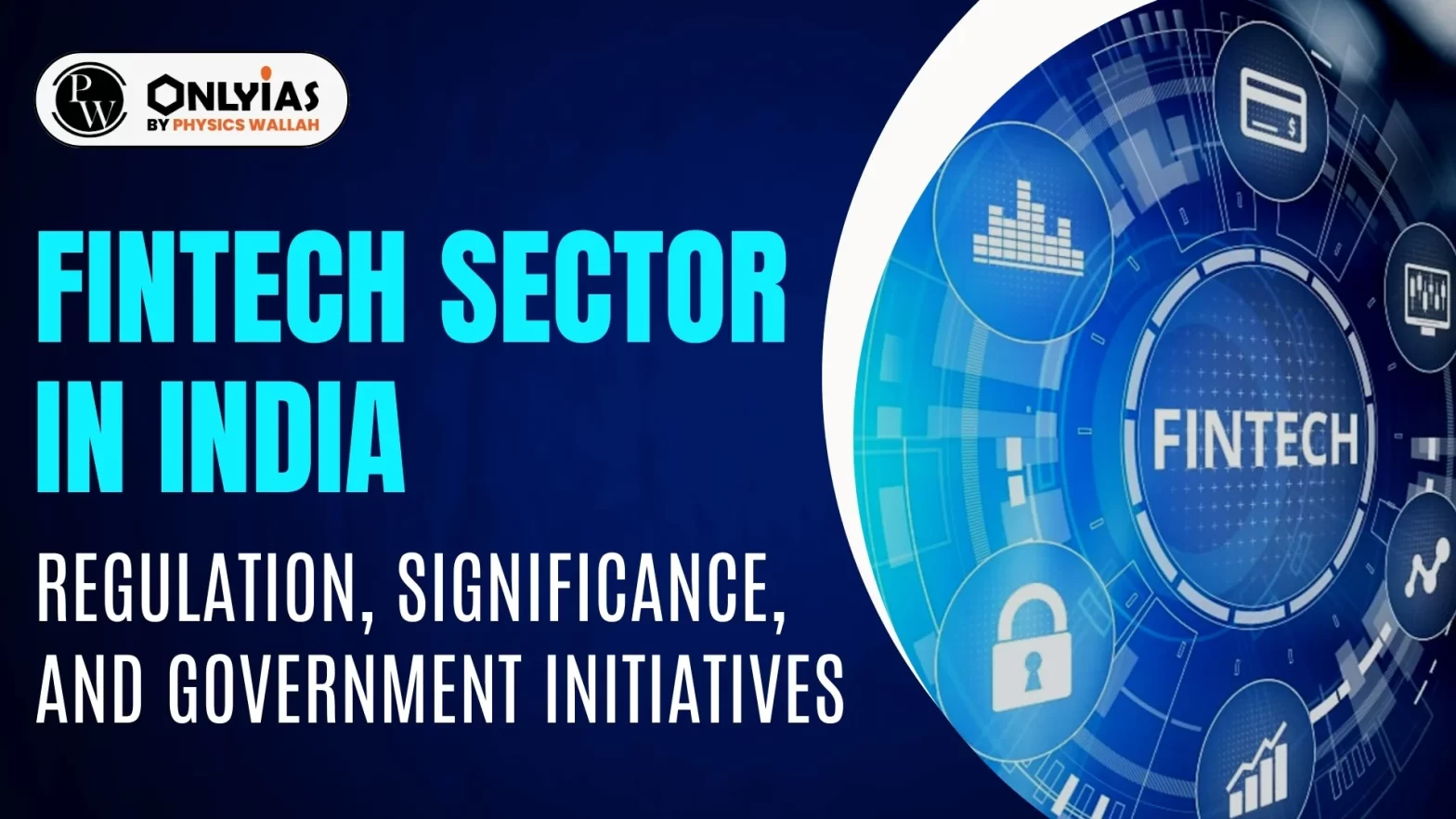Context: The Reserve Bank of India (RBI) recently directed banks and non-banking financial companies (NBFCs) to increase their risk weightage against such loans from 100 per cent to 125 per cent.
| Relevancy for Prelims: Fintech Companies in India, NBFCs, National Centre for Financial Education, Digital Rupee, and Unified Payments Interface.
Relevancy for Mains: Fintech Sector in India: Regulation, Significance, and Government Initiatives. |
Current Challenges in Indian Fintech Startups
- Rise in cost of Loans: Banks and NBFCs will need more capital, which will lead to an increase in the interest rates for loans to consumers. This will have a direct impact on fintech firms.
- Fintech companies facing a funding crunch may be forced to seek capital through the public markets with a greater share of unsecured loans.
- Decline in Fintech Funding: The year 2023 witnessed a steep decline in funding by Indian fintech startups, mainly due to a decline in seed-stage funding.
- FinTechs in India raised only USD 2.1 billion in 2023, down by almost 300 per cent as compared to 2022.
What is Fintech?
- Fintech, a combination of the terms “financial” and “technology,” refers to businesses that use technology to enhance or automate financial services and processes.
Fintech Companies in India: Types
- Payment: These offer digital payment solutions, such as mobile wallets, online payment gateways, and peer-to-peer (P2P) payments. Ex-Bharatpe
- Lending: These offer digital lending solutions, such as personal loans, business loans, and credit cards. Ex-CRED
- Insurance: These offer digital insurance solutions, such as health insurance, life insurance, and car insurance.Ex-Digit Insurance
- Investment: They offer digital investment solutions, such as stock trading, mutual funds, and cryptocurrency trading. Ex-Zerodha
- RegTech: They offer regulatory technology solutions, such as compliance software and risk management tools. Ex-Razorpay
Fintech Sector: Its Significance to India
- Fintech Sector: India is home to the third-highest number of fintechs globally, with more than 9,000 fintechs, holding a 14 per cent share of Indian start-up funding.
- Adoption Rate: As per the Economic Survey 2022-23, Indian fintech companies witnessed an 87% adoption rate across varied user bases as opposed to the global average rate of 64%.
- Digital Transactions: Fintech companies account for 70 per cent of digital payment transactions, marking a twofold rise in their share during FY22 compared to FY19.
- Financial Inclusion: More than 10 million people and small businesses gained access to savings accounts, insurance, investment options, and credit facilities through mobile-based services and digital platforms.
- The adult population with bank accounts increased from 53% to 78%.
- Democratising Lending Process: Peer-to-peer lending platforms are democratizing lending, providing individuals and small businesses with access to funds without the need for traditional financial institutions.
- Mobile payment platforms and digital wallets offer users a convenient and secure transaction method.
- Rise in Public Investment: Investment platforms and robo-advisors are making investing in stocks, mutual funds, and other financial instruments more accessible..
- These platforms use advanced algorithms and artificial intelligence to provide personalized investment advice, enhancing the efficiency and affordability of wealth management services.
Government Initiatives Supporting Fintech Penetration in India
- JAM Trinity:
- Jan Dhan Yojana: It has helped in new bank account enrolment of over 508.9 Mn beneficiaries
- Aadhaar: The world’s largest biometric identification system (>1.3 Bn Aadhaars generated so far)
- Mobile connectivity: India has the 2nd highest number of smartphone users
- India Stack: It is a set of APIs that allows governments, businesses, startups and developers to utilise unique digital Infrastructure to solve India’s hard problems towards presence-less, paperless, and cashless service delivery.
- UPI (Unified Payments Interface): The advanced mobile app-based payment system is the multiplier force behind the Fintech revolution in India.
- Cross-border linkage of UPI & RuPay network with other countries enhances the global footprint.
- Digital Rupee: Central Bank Digital Currency (CBDC) or digital rupee is an electronic version of cash helping accelerate the growth of the FinTech market in India.
Continue Reading: E-Rupee’s Journey
- Open Network for Digital Commerce (ONDC): It fosters a competitive and inclusive digital commerce ecosystem.
- It supports the digitization of small businesses by linking them with a payments and logistics infrastructure.
- Open Credit Enablement Network (OCEN): It democratises credit for small borrowers and enables lending as a feature for marketplaces.
- National Centre for Financial Education: It aims to promote financial education across India for all sections of the population.
What challenges are associated with Fintech lending?
- Cyber Attacks: The increasing digitization of financial services has increased the risks of cyber threats.
- Recent data from the Indian Computer Emergency Response Team (CERT-In) highlights that almost 100% of fintech companies had issues related to privacy, security, and compliance, owing to APIs, subdomains, and abandoned web applications.
- In 2022, a total of 13.91 lakh cases were reported.
Continue Reading: NCRB Report 2022 On Crime In India
- Regulatory Issues: The absence of a single umbrella legislation regulating the sector’s functioning, constantly evolving regulations and numerous regulatory approvals pose a major challenge to FinTechs in India.No specific set of laws and regulations governing fintech services and products in the country.
- Illegal Digital Lending: The ease of access to fintech loan apps has led to a rise in numerous instances of harassment, unethical recovery practices and suicide linked to unregulated lending apps.
- Digital lending is a method that uses digital platforms for ” customer acquisition, credit assessment, loan approval, disbursement, recovery, and associated customer services.”
- A recent incident reported involved the arrest of two individuals from Assam linked to a case where an individual’s suicide was connected to an online loan probe.
- Financial Illiteracy: There is a lack of necessary digital exposure and adequate digital knowledge to understand the risks associated with online transactions.
- This lack of awareness leads to risky behaviours, such as sharing passwords and personal information.
- Infrastructural Issues: Due to network/ connectivity problems in rural areas, online transactions are more prone to interruptions and slower response times, leading to security threats.
- Co-Lending Partnerships: There is an increasing number of fintech firms entering into co-lending partnerships with banks and Non-Banking Financial Companies (NBFCs).
-
- This has created complicated lending layers, posing challenges for the regulator in monitoring connected-party lending.
- In response, the RBI has advocated for a comprehensive framework to oversee such lending, ensuring uniform application across all entities regulated by the RBI.
- Data Privacy Issues: The RBI has mandated that all financial institutions conduct Know Your Customer (KYC) verification for each customer.
- It necessitates huge amounts of company funds, given the substantial number of customers and the need for the data to be collected, stored, and monitored.
- Private data and sensitive information are at risk with every digital and electronic transaction as the businesses exploit this data for financial gain.
Fintech Sector Regulation in India
- PSS Act (Payment and Settlement Systems Act (2007): It forbids the establishment and operation of any ‘payment system’ in India without the prior approval of the RBI.
- Peer-to-Peer Lending Platform Directions of 2017: It defines the lender exposure rules and borrowing restrictions regarding the activities of P2P lending platforms in India.
- NCPI(National Payments Corporation of India) Regulations on UPI Payments: According to this framework, banks must create money transfer services using UPI platforms.
- Banks may contract with technology suppliers to operate mobile applications for UPI payments, but only under the NCPI’s eligibility requirements and prudential standards.
- NPCI acts as a Quasi regulatory for UPI and Rupay.
- NBFC Regulations: All NBFCs are governed by the RBI Act of 1934. According to the RBI’s requirements, every organization providing fintech services in India must be registered.
- Payment banks: Specific licensing requirements limit the banks’ activities, particularly accepting demand deposits and on payments.
- Working Group on Digital Lending 2021: To study all aspects of digital lending activities by regulated and unregulated entities/players in the financial sector to regulate digital lending in India.
- Cryptocurrency Regulations: The RBI issued a notification in 2021 by RBI under which all the banks have to use precautions in dealing with cryptocurrency.
- Regulations for Payment Aggregator: Under Cross Border (PA-CB Guidelines), fintechs are empowered to aggregate cross-border payments for the import and export of goods and services, offering fintechs a well-defined structure for cross-border transactions, which were previously limited.
- Regulatory Sandbox Framework: It allows FinTech companies to test their products and services in a controlled environment, fostering innovation while maintaining regulatory oversight.
|
Way Forward
- Strengthening the Cybersecurity Infrastructure: A robust cybersecurity regulation is the first defence against cyberattacks and fraud.
- Fintech companies can collaborate with local law enforcement agencies to address cyber threats specific to the region.
- Reporting mechanisms for cybercrimes can also be established to encourage users to report any suspicious activities.
- Improving the Cybersecurity of payment infrastructure in rural India: Fintech applications should have robust security features, including multi-factor authentication, encryption, and biometric recognition.
- These security layers can significantly reduce the risk of unauthorised access to financial data. Companies must prioritise the security of users and personal and financial data.
- Addressing Infrastructural issues: Given the intermittent internet connectivity in rural areas, fintech companies should enable offline access to financial services simultaneously.
- This will ensure that users can perform essential transactions with limited or no internet connectivity..
- Digital Literacy Programs: Fintech firms should invest in digital literacy programs to educate rural users about the risks and best practices associated with online transactions.
- These campaigns can reach a broader audience by collaborating with local organizations and government bodies.
- Offering 24/7 customer support and educational resources in local languages can bridge the knowledge gap and help rural users navigate any issues.
- Fintech companies can organise community outreach programs to connect with rural users directly.
- Creation of a unified regulatory framework on connected lending: As suggested by RBI, this must be created to regulate connected lending – where a borrower might influence the lender’s decision – for all its regulated entities.
- Compliance Program for Fintechs: Fintechs should develop a compliance program to ensure they comply with all applicable laws and regulations.
- It should include policies and procedures for managing risk, conducting due diligence on customers and counterparties, and reporting suspicious activity to the authorities.
Conclusion
The Indian Fintech sector faces challenges in funding and regulation, requiring collaborative efforts for sustainable growth and financial inclusion.
News Source: Business Standard
To get PDF version, Please click on "Print PDF" button.

